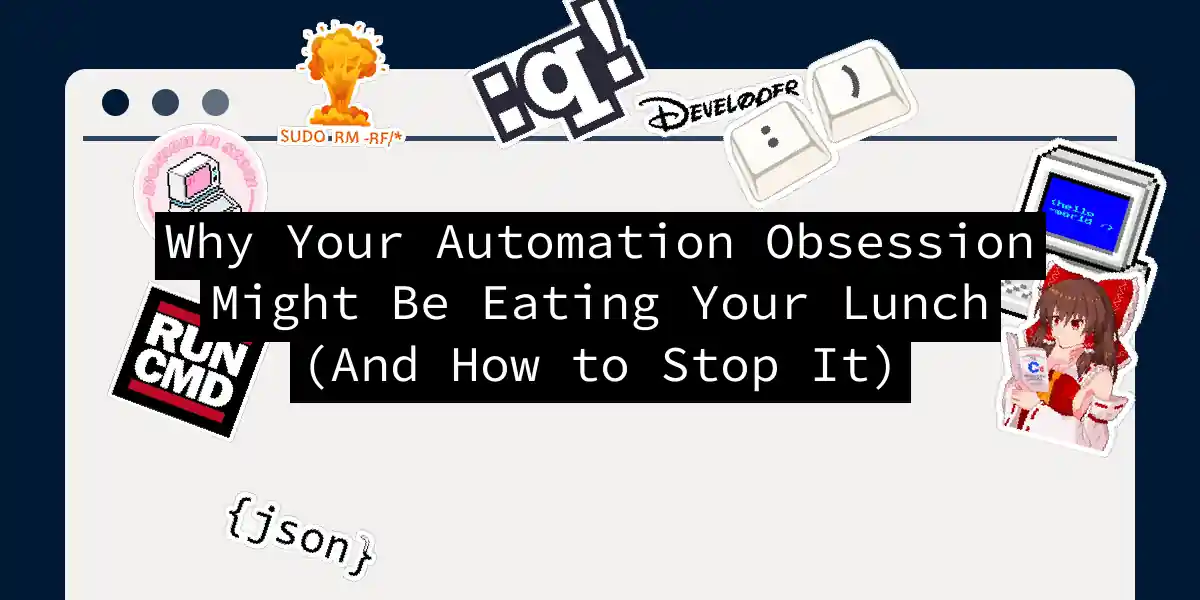Picture this: You’ve just spent 3 days automating your deployment pipeline. The script is 842 lines of YAML spaghetti. It breaks on Sundays. Your CI/CD system now needs therapy. Welcome to automation theater - where we solve problems we created by buying more keyboards.
# The moment you realize automation isn't magic
def should_automate(task):
time_saved = estimate_time(task)
setup_cost = random.randint(100, 500) # Because who actually tracks this?
return (time_saved > setup_cost) and ("boss asked for it" in sys.argv)
When Robots Cry: Automation Horror Stories
The Case of the Phantom Clicker
Last quarter, I built a beautiful Selenium test suite. It worked perfectly until Marketing changed “Sign Up” to “Get Started!” - suddenly our test suite thought it was clicking a cat video. 127 failed tests later, we learned:
// Anti-pattern: Element locators more fragile than house of cards
await driver.findElement(By.xpath('//*[@id="app"]/div/button'));
// Better approach: Use stable test IDs
await driver.findElement(By.id('signup-submit'));
The solution? We implemented resilient selectors and added visual regression testing . Total time spent fixing automation: 40 hours. Time saved: Negative 15 hours. Oops.
The Hidden Cost Calculator (TW: Math)
Automation ROI isn’t just about time saved. Let’s break it down: ( \text{Real Savings} = \frac{\text{Time Saved} - (\text{Maintenance} + \text{Context Switching})}{\text{Coffee Spilled}} ) Real-world example:
- Manual testing: 2hrs/week
- Automation setup: 20hrs
- Maintenance: 1hr/week
- Break-even point: ( \frac{20}{2-1} = 20 ) weeks
By week 10, the framework was obsolete. We paid 10hrs to save 10hrs. Classic automation equilibrium.
When to Say “Hard Pass” to Automation
Through painful experience (and several broken keyboards), I’ve developed the Zhirnov Veto Criteria:
- The “Snowflake” test
If the process changes faster than TikTok trends (looking at you, marketing teams) - The Cost-of-Failure Index
( \text{COFI} = \frac{\text{Downtime Cost}}{\text{Manual Recovery Time}} )
If COFI > 100, maybe don’t let robots drive - The Pizza Rule
If the task takes less time than eating a cold slice while debugging - just do it manually
# Quick automation sniff test
if [[ "$(curl -s https://api.sanity-check.com/automation-appropriate)" == "false" ]]; then
echo "Put the robot down slowly..."
exit 1
fi
The Art of Semi-Automation: 80/20 Rule in Action
Sometimes the smart play is making things 80% easier without full automation:
def generate_migration_template():
"""Semi-automated DB migration helper"""
timestamp = datetime.now().strftime("%Y%m%d_%H%M")
print(f"# Run this on production? (y/N)")
print(f"# File saved as migration_{timestamp}.sql")
print(f"ALTER TABLE users ADD COLUMN existential_crisis BOOLEAN DEFAULT FALSE;")
This approach:
- Handles boilerplate
- Enforces standards
- Keeps humans in the loop
(And prevents robots from dropping production tables at 3 AM)
Automation Detox: Recovering from Over-Automation
If your infrastructure has more moving parts than a Rube Goldberg machine, try:
- The Sunset Clause
- [ ] Delete automation if unused for 3 months - [ ] Archive configuration after 6 months - [ ] Host robot funeral annually - Manual Mondays
Once a month, do tasks manually. You’ll either:- Rediscover why you automated it
- Realize automation was overkill
- Develop carpal tunnel (win-win!)
- Automation Accounting
Track actual vs predicted savings in a spreadsheet. Bonus points for making the spreadsheet self-updating (meta-automation!)
Conclusion: Be the Automation Gardener
Automation should be like a well-tended garden, not kudzu that swallows your codebase. Next time you reach for that automation hammer:
- Ask “Is this a nail or a water balloon?”
- Calculate the real ROI (including sanity points)
- Consider semi-automation
- Always keep pruning shears handy Remember: Every minute spent fixing flaky tests is a minute not spent writing sarcastic comments in code. Choose wisely.
